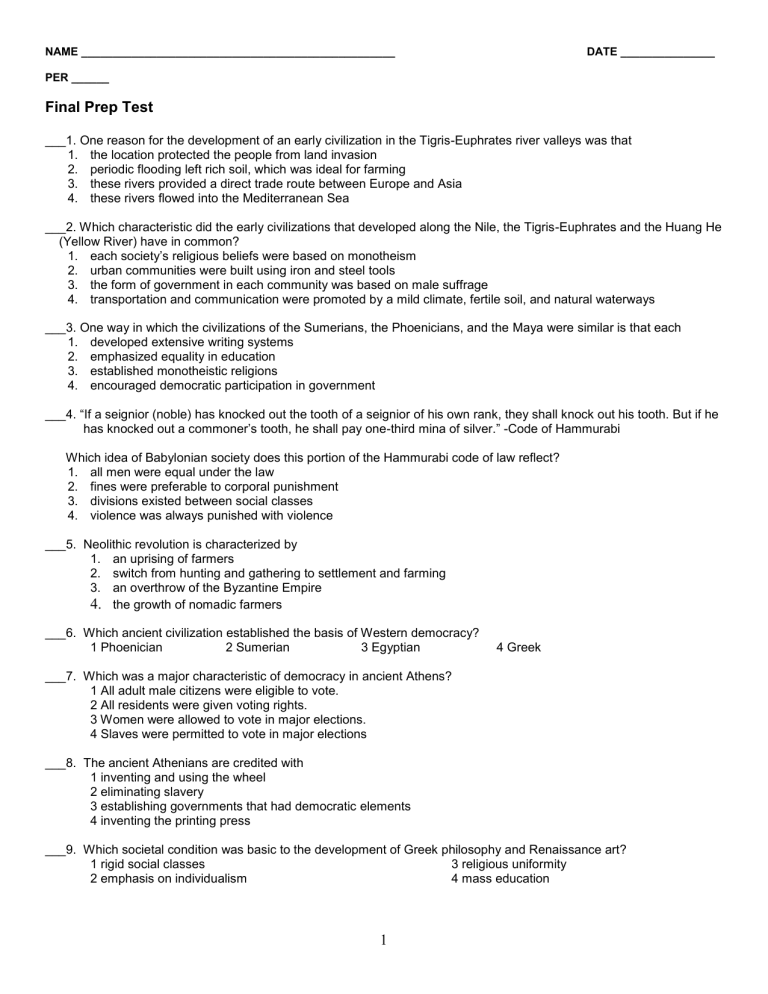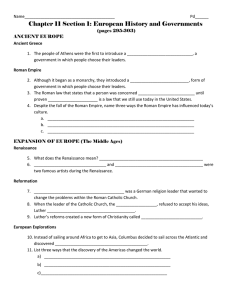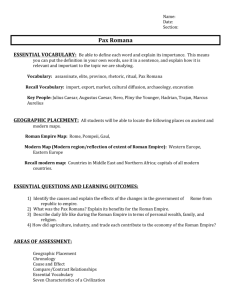Final Prep Test

NAME __________________________________________________
PER ______
DATE _______________
Final Prep Test
___1. One reason for the development of an early civilization in the Tigris-Euphrates river valleys was that
1. the location protected the people from land invasion
2. periodic flooding left rich soil, which was ideal for farming
3. these rivers provided a direct trade route between Europe and Asia
4. these rivers flowed into the Mediterranean Sea
___2. Which characteristic did the early civilizations that developed along the Nile, the Tigris-Euphrates and the Huang He
(Yellow River) have in common?
1. each society’s religious beliefs were based on monotheism
2. urban communities were built using iron and steel tools
3. the form of government in each community was based on male suffrage
4. transportation and communication were promoted by a mild climate, fertile soil, and natural waterways
___3. One way in which the civilizations of the Sumerians, the Phoenicians, and the Maya were similar is that each
1. developed extensive writing systems
2. emphasized equality in education
3. established monotheistic religions
4. encouraged democratic participation in government
___4. “If a seignior (noble) has knocked out the tooth of a seignior of his own rank, they shall knock out his tooth. But if he has knocked out a commoner’s tooth, he shall pay one-third mina of silver.” -Code of Hammurabi
Which idea of Babylonian society does this portion of the Hammurabi code of law reflect?
1. all men were equal under the law
2. fines were preferable to corporal punishment
3. divisions existed between social classes
4. violence was always punished with violence
___5. Neolithic revolution is characterized by
1. an uprising of farmers
2. switch from hunting and gathering to settlement and farming
3. an overthrow of the Byzantine Empire
4.
the growth of nomadic farmers
___6. Which ancient civilization established the basis of Western democracy?
1 Phoenician 2 Sumerian 3 Egyptian
___7. Which was a major characteristic of democracy in ancient Athens?
4 Greek
1 All adult male citizens were eligible to vote.
2 All residents were given voting rights.
3 Women were allowed to vote in major elections.
4 Slaves were permitted to vote in major elections
___8. The ancient Athenians are credited with
1 inventing and using the wheel
2 eliminating slavery
3 establishing governments that had democratic elements
4 inventing the printing press
___9. Which societal condition was basic to the development of Greek philosophy and Renaissance art?
1 rigid social classes
2 emphasis on individualism
3 religious uniformity
4 mass education
1
___10. The Golden Age of Greece and the Renaissance in Europe were both characterized mainly by
1 religious revival 3 economic decline
2 social reform and political upheaval 4 Artistic and literary achievements
"… for the administration is in the hands of the many and not of the few
… an Athenian citizen does not neglect the state because he takes care of his own household. . . . We alone regard a man who takes no interest in public affairs, not as a harmless but as a useless character…"
- Pericles, 431 B.C.
___ 11. Which type of political system does this quotation suggest that people of ancient Athens valued?
1 monarchy 2 aristocracy 3 democracy 4 autocracy
"
Let me say that our system of government does not copy the institutions of our neighbors. It is more the case of our being a model to others than of our imitating anyone else. Our constitution is called a democracy because power is in the hands, not of a minority, but of the whole people."
___12. Which early society is most likely described in this quotation?
1 Spartan 2 Athenian 3 Babylonian 4 Egyptian
___13. A major impact of ancient Greece and Rome on Western civilization was that
1 the Greeks and Romans succeeded in achieving a classless society, which was later copied in western Europe
2 Greek sculpture and Roman architecture were much admired and copied in the 18 th and 19 th centuries'
3 Greece and Rome transmitted Islamic philosophy to the areas they conquered
4 Greek and Latin are still widely spoken in universities throughout the West
___14. Impact of long-term contributions of ancient Greek and Roman civilizations are primarily found in the area of
1 military technology 3 economic policy and planning
2 religious doctrine 4 government and law
___15. The ancient Romans most significant contribution to Europe has been in the area of
1 economics 2 drama 3 poetry 4 law
___ 16. The political system of the ancient Roman Empire was characterized by
1 a strong central government
2 rule by a coalition of emperors and religious leaders
3 universal suffrage in national elections
4 a strict adherence to constitutional principles
___ 17. An immediate result of the fall of the Roman Empire was
1 a renewed interest in education and the arts
2 a period of disorder and weak central government
3 an increase in trade and manufacturing
4 the growth of cities and dominance by the middle class'
"Western Europe owed a debt of gratitude to the Empire that for almost a thousand years ensured the survival of Christianity during a time when
Europe was too weak to accomplish the task."
___ 18. Which empire is referred to in this quotation?
1 Hellenistic 2 Byzantine 3 Mongol 4 Ottoman
___ 19. Rome during the Pax Romana and the Catholic Church during the Middle Ages are examples of
1 constitutional monarchies
2 centralized powers
3 feudal governments
4 Communist regimes
2
___20. A major reason for the decline of the Roman Empire was
1 a series of military defeats in Africa
2 political corruption and the instability of the government
3 the abolition of slavery through out the Empire
4 continued acceptance of traditional religions
___ 21. Which characteristic was common to the Golden Age of Greece and the Italian Renaissance
1 A strong military led to national unity.
2 Written constitutions led to the establishment of democratic governments.
3 Prosperity led to the creation of many works of art.
4 Political instability led directly to the formation of unified nation-states.
___ 22. A major effect of the decline of the Roman Empire was that western Europe
1 came under the control of the Muslims 3 returned to a republican form of government
2 was absorbed by the Byzantine Empire 4 entered a period of chaos and disorder
___ 23. After the fall of Rome, the eastern portion of the Roman Empire became known as the
1 Persian Empire 2 Mongol Empire 3 Byzantine Empire 4 Gupta Empire
___ 24. All citizens in ancient Athens had the right to attend the Assembly, where they could meet in open discussion and cast votes. This situation is an example of
1 direct democracy 3 parliamentary democracy
2 totalitarianism 4 absolutism
___ 25. A major contribution of the Roman Empire to Western society was the development of
1 gunpowder 3 monotheism
2 the principles of revolutionary socialism 4 an effective legal system
___ 26. Which European historical periods are in the proper chronological order?
1 Middle Ages Renaissance Ancient Greece Roman Empire
2 Renaissance Ancient Greece Roman Empire Middle Ages
3 Ancient Greece Roman Empire Middle Ages Renaissance
4 Roman Empire Middle Ages Renaissance Ancient Greece
___27. Which was a characteristic of feudalism in Europe?
1. The feudal system encouraged social change.
2. The feudal manor traded with faraway nations.
3. The feudal manor provided for most of its own needs
4. The people elected feudal leaders.
___28. Feudalism, in Europe during the Middle Ages was characterized by
1. an international trade system 3. control over foreign nations
2. equal rights for all people 4. a rigid social class system
___29. The political and economic system that existed in medieval Europe is known as
1. feudalism 2. manorialism 3. socialism 4. capitalism
___30. In European feudal society, an individual's social status was generally determined by
1. Birth 2. education and training 3. individual abilities 4. marriage
___31. “In some parts of Europe, trade declined, barter replaced money, and there was no strong central government.
Constant invasions caused people to concentrate on survival.”
Which historical period is described in this quotation?
1. Age of Exploration 2. Reformation 3. Early Middle Ages 4. Pax Romana
3
___32. “All things were under its domain...its power was such that no one could hope to escape its scrutiny.”
Which European institution during the Middle Ages is best described by this statement?
1. the Guild 2. Knighthood 3. the Church 4. the nation-state
___33. The Middle Ages in Western Europe was characterized by
1. the manor system and the importance of land ownership
2. absolute monarchies and strong central governments
3. decreased emphasis on religion in daily life
4. extensive trade with Asia and the Middle East
___34. Which economic system existed in Europe during the early Middle Ages?
1. free market 2. manorialism 3. socialism 4. command
___35. The growth of feudalism in Europe during the Middle Ages was primarily caused by the
1. rivalry between the colonial empires
2. suppression of internationalism
3. decline of the Roman Catholic Church
4. collapse of a strong central government
___36. The Roman Catholic Church during the Middle Ages in Europe can best be described as a church that
1. favored separation from secular governments
2. avoided involvement in social and educational matters
3. was a strong force that divided many people
4. was a stabilizing influence during a period of weak central governments
___37. Which was a characteristic of feudalism?
1. land was exchanged for military service and obligations
2. government was provided by a bureaucracy of civil servants
3. power rested in the hands of a string central government
4. unified national court systems were developed
___38. In Western Europe, which development caused the other three?
1. decline of trade 3. fall of Roman Empire
2. breakdown of central government 4. rise in the power of the Roman Catholic Church
___39. The Eightfold Path, the Four Noble Truths, and the concept of nirvana are associated with the religion of
1. Hinduism 3. Jainism
2. Shinto 4. Buddhism
___40. One way in which the Vedas, the Bible, and the Quran are both similar is that they
1. provide guidelines to govern the behavior of believers
2. deny the existence of a supreme being who rules the universe
3. encourage strife between segments of believers
4. support political rebellions that overthrow governments
___41. The Quran, Mecca, and the hijra are most closely associated with
1. Islam 3. Buddhism
2. Judaism 4. Christianity
___42. One similarity between the Five Pillars of Islam and the Ten Commandments is that both
1. support reincarnation
2. promote learning as a means to salvation
3. encourage the use of statues to symbolize gods
4. provide a guide to proper moral and ethical behavior
4
___43. In India, which aspect of society has been most heavily influenced by religious beliefs, tradition and division of labor?
1. caste system
2. urbanization
3. policy of neutrality
4. parliamentary government
___44. The West African kingdoms of Ghana, Mali, and Songhai flourished between A.D. 700 and A.D. 1600 mainly
because they
1. controlled the trade routes across the Sahara
2. developed self-sufficient economies
3. became religious centers considered sacred by Africans
4. received support from European colonial governments
___45. Before West African civilizations had contact with Europeans, these civilizations developed
1. art that included bronze, gold, and clay sculptures.
2. economies that did not rely on trade.
3. one system of government for the entire region.
4. social systems that emphasized the nuclear family.
___46. During the Middle Ages, Europeans did not eat potatoes or corn because these vegetables
1. were forbidden by the Catholic Church for religious reasons.
2. had not yet been introduced to Europe from the New World.
3. were believed to be poisonous.
4. were too expensive to import from China.
___47. In the ancient kingdom of Mali and in the Roman Republic, an important feature of life was the development of
1. codified laws. 3. social and political equality.
2. the Islamic religion. 4. agricultural communes.
___48. As the Middle Ages ended, the rise of a middle class in Western Europe can be attributed partly to the
1. economic policies of the Roman empire.
2. increase in trade that resulted from the Crusades.
3. strength of Christianity in medieval Europe.
4. self-sufficiency of the manor system.
___49. The Magna Carta was important to the development of democracy because it
1. limited the power of the monarch. 3. created a bicameral legislature.
2. took land away from the nobles. 4. extended the right to vote to peasants.
___50. An immediate result of the Protestant Reformation was the
1. end of religious unity in Europe.
2. translation of the Koran (Qur'an).
3. increase in power of the Roman Catholic Church.
4. destruction of the increasing power of monarchs.
5





